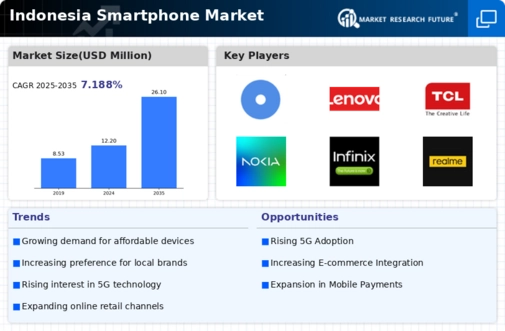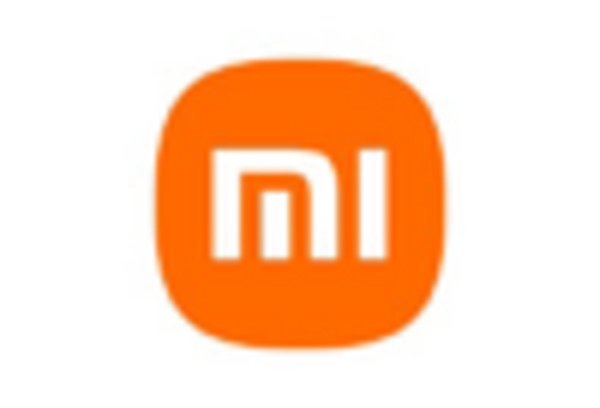Rising Disposable Income
In Indonesia, the rising disposable income among the middle class is significantly impacting the smartphone market. As of November 2025, the average disposable income has increased by approximately 10% over the past year, allowing consumers to allocate more funds towards technology purchases. This economic growth is fostering a culture of consumerism, where individuals are more inclined to invest in smartphones that offer advanced features and capabilities. The smartphone market is likely to benefit from this trend, as brands introduce a wider range of devices catering to various price segments. Consequently, the competition among manufacturers intensifies, leading to innovation and improved product offerings.
Growing Demand for Mobile Gaming
The smartphone market in Indonesia is witnessing a significant boost from the growing demand for mobile gaming. As of November 2025, it is estimated that over 50% of smartphone users engage in mobile gaming, which has become a popular pastime. This trend is driving manufacturers to develop smartphones with enhanced graphics, processing power, and battery life to cater to gamers. The increasing popularity of e-sports and mobile gaming tournaments further fuels this demand, as consumers seek devices that can provide an optimal gaming experience. Consequently, the smartphone market is likely to see a rise in sales of high-performance devices, as brands compete to capture the attention of this lucrative segment.
Expansion of E-commerce Platforms
The expansion of e-commerce platforms in Indonesia is playing a crucial role in shaping the smartphone market. As of November 2025, online shopping has gained immense popularity, with over 60% of consumers preferring to purchase smartphones through digital channels. This shift towards e-commerce is prompting manufacturers to enhance their online presence and offer exclusive deals to attract consumers. Additionally, the convenience of online shopping encourages users to explore a wider range of smartphone options, leading to increased sales. The smartphone market is likely to benefit from this trend, as e-commerce platforms continue to evolve and provide seamless shopping experiences for consumers.
Increasing Mobile Internet Penetration
The smartphone market in Indonesia is experiencing a notable surge due to the increasing penetration of mobile internet services. As of November 2025, approximately 75% of the population has access to mobile internet, which facilitates the adoption of smartphones. This connectivity enables users to engage in various online activities, including social media, e-commerce, and streaming services. The growing reliance on mobile internet is likely to drive demand for smartphones, as consumers seek devices that can support high-speed connectivity and data-intensive applications. Furthermore, the expansion of 4G and 5G networks across urban and rural areas enhances the smartphone market, as users are encouraged to upgrade to devices that can leverage these advanced technologies.
Technological Advancements in Smartphone Features
Technological advancements in smartphone features are significantly influencing the smartphone market in Indonesia. As of November 2025, consumers are increasingly seeking devices equipped with cutting-edge technologies such as artificial intelligence, advanced camera systems, and enhanced security features. This demand for innovation is prompting manufacturers to invest in research and development, resulting in the introduction of smartphones that cater to the evolving preferences of consumers. The smartphone market is likely to see a proliferation of devices that incorporate these advanced features, as brands strive to differentiate themselves in a competitive landscape. This trend not only enhances user experience but also drives overall market growth.
















Leave a Comment